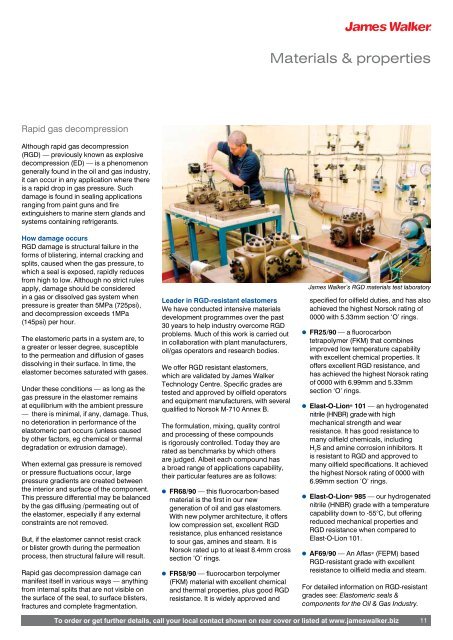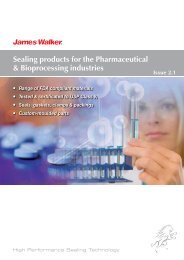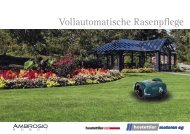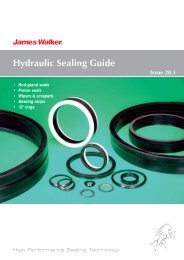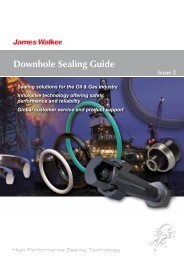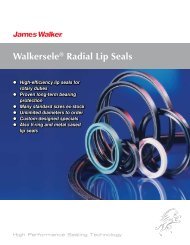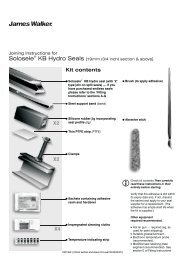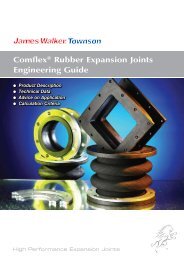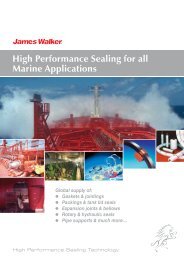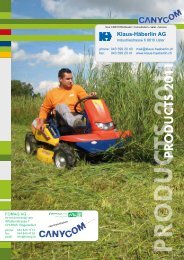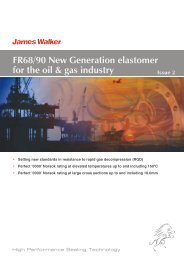'O' Ring Guide
'O' Ring Guide
'O' Ring Guide
You also want an ePaper? Increase the reach of your titles
YUMPU automatically turns print PDFs into web optimized ePapers that Google loves.
Materials & properties<br />
Rapid gas decompression<br />
Although rapid gas decompression<br />
(RGD) — previously known as explosive<br />
decompression (ED) — is a phenomenon<br />
generally found in the oil and gas industry,<br />
it can occur in any application where there<br />
is a rapid drop in gas pressure. Such<br />
damage is found in sealing applications<br />
ranging from paint guns and fire<br />
extinguishers to marine stern glands and<br />
systems containing refrigerants.<br />
How damage occurs<br />
RGD damage is structural failure in the<br />
forms of blistering, internal cracking and<br />
splits, caused when the gas pressure, to<br />
which a seal is exposed, rapidly reduces<br />
from high to low. Although no strict rules<br />
apply, damage should be considered<br />
in a gas or dissolved gas system when<br />
pressure is greater than 5MPa (725psi),<br />
and decompression exceeds 1MPa<br />
(145psi) per hour.<br />
The elastomeric parts in a system are, to<br />
a greater or lesser degree, susceptible<br />
to the permeation and diffusion of gases<br />
dissolving in their surface. In time, the<br />
elastomer becomes saturated with gases.<br />
Under these conditions — as long as the<br />
gas pressure in the elastomer remains<br />
at equilibrium with the ambient pressure<br />
— there is minimal, if any, damage. Thus,<br />
no deterioration in performance of the<br />
elastomeric part occurs (unless caused<br />
by other factors, eg chemical or thermal<br />
degradation or extrusion damage).<br />
When external gas pressure is removed<br />
or pressure fluctuations occur, large<br />
pressure gradients are created between<br />
the interior and surface of the component.<br />
This pressure differential may be balanced<br />
by the gas diffusing /permeating out of<br />
the elastomer, especially if any external<br />
constraints are not removed.<br />
But, if the elastomer cannot resist crack<br />
or blister growth during the permeation<br />
process, then structural failure will result.<br />
Rapid gas decompression damage can<br />
manifest itself in various ways — anything<br />
from internal splits that are not visible on<br />
the surface of the seal, to surface blisters,<br />
fractures and complete fragmentation.<br />
Leader in RGD-resistant elastomers<br />
We have conducted intensive materials<br />
development programmes over the past<br />
30 years to help industry overcome RGD<br />
problems. Much of this work is carried out<br />
in collaboration with plant manufacturers,<br />
oil/gas operators and research bodies.<br />
We offer RGD resistant elastomers,<br />
which are validated by James Walker<br />
Technology Centre. Specific grades are<br />
tested and approved by oilfield operators<br />
and equipment manufacturers, with several<br />
qualified to Norsok M-710 Annex B.<br />
The formulation, mixing, quality control<br />
and processing of these compounds<br />
is rigorously controlled. Today they are<br />
rated as benchmarks by which others<br />
are judged. Albeit each compound has<br />
a broad range of applications capability,<br />
their particular features are as follows:<br />
l FR68/90 — this fluorocarbon-based<br />
material is the first in our new<br />
generation of oil and gas elastomers.<br />
With new polymer architecture, it offers<br />
low compression set, excellent RGD<br />
resistance, plus enhanced resistance<br />
to sour gas, amines and steam. It is<br />
Norsok rated up to at least 8.4mm cross<br />
section ‘O’ rings.<br />
l FR58/90 — fluorocarbon terpolymer<br />
(FKM) material with excellent chemical<br />
and thermal properties, plus good RGD<br />
resistance. It is widely approved and<br />
James Walker’s RGD materials test laboratory<br />
specified for oilfield duties, and has also<br />
achieved the highest Norsok rating of<br />
0000 with 5.33mm section ‘O’ rings.<br />
l FR25/90 — a fluorocarbon<br />
tetrapolymer (FKM) that combines<br />
improved low temperature capability<br />
with excellent chemical properties. It<br />
offers excellent RGD resistance, and<br />
has achieved the highest Norsok rating<br />
of 0000 with 6.99mm and 5.33mm<br />
section ‘O’ rings.<br />
l Elast-O-Lion ® 101 — an hydrogenated<br />
nitrile (HNBR) grade with high<br />
mechanical strength and wear<br />
resistance. It has good resistance to<br />
many oilfield chemicals, including<br />
H 2<br />
S and amine corrosion inhibitors. It<br />
is resistant to RGD and approved to<br />
many oilfield specifications. It achieved<br />
the highest Norsok rating of 0000 with<br />
6.99mm section ‘O’ rings.<br />
l Elast-O-Lion ® 985 — our hydrogenated<br />
nitrile (HNBR) grade with a temperature<br />
capability down to -55°C, but offering<br />
reduced mechanical properties and<br />
RGD resistance when compared to<br />
Elast-O-Lion 101.<br />
l AF69/90 — An Aflas ® (FEPM) based<br />
RGD-resistant grade with excellent<br />
resistance to oilfield media and steam.<br />
For detailed information on RGD-resistant<br />
grades see: Elastomeric seals &<br />
components for the Oil & Gas Industry.<br />
To order or get further details, call your local contact shown on rear cover or listed at www.jameswalker.biz 11


